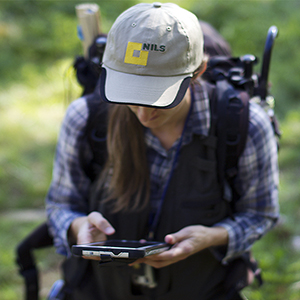The Purpose of the Inventories
The purpose of the inventories is to collect, analyze, and present data on the state and changes of landscapes in Sweden over time. These inventories are focused towards coastal areas, alpine mountainous regions, grasslands, and mature deciduous forests. One of the key uses of the data collected is to report on the area and quality of habitats listed in Annex 1 of the EU's Habitat Directive, which is reported to the EU. Furthermore, our data is used to monitor progress towards the Swedish Environmental Objectives and to develop national land cover data.
Working with NILS
NILS is operated by the Landscape Analysis division within the Department of Forest Resource Management at SLU. Our team consists of approximately 15 permanent employees who specialize in sampling design, field inventory, aerial image inventory, remote sensing, statistical analysis, and data systems for environmental monitoring programs. Our staff members are based throughout Sweden in Småland, Uppland, Norrbotten and Västerbotten, with the majority located in Umeå. Additionally, we hire 20-30 seasonal field inventors from across Sweden every year.
Funding
Our inventories are commissioned by the Swedish Environmental Protection Agency and the Swedish Board of Agriculture.
Our inventories
National Inventories of Landscapes in Sweden – NILS is a national environmental monitoring program under which several inventories are gathered.
NILS Grassland inventory - A national inventory of all types of grasslands, but with extra emphasis on grasslands with high nature values (designated in Annex 1 of the EU's Habitat Directive). 2020 - ongoing.
NILS Deciduous forest inventory - A national inventory of old deciduous forests that complements data from the National Forest Inventory. The focus is on Quercus, Fagus, Tilia, Acer, Fraxinus, or Ulmus rich forests i.e. broad-leaf forests, swamp deciduous forests, alluvial deciduous forests and other old deciduous forests. Started in 2020.
NILS Alpine mountain inventory - A national inventory of the alpine area but with a focus on nature types with high nature values (designated in Annex 1 of the EU's Habitat Directive). Started in 2021.
THUF Seashore inventory - A national inventory of the Swedish coast and archipelago, with a focus on habitats included in Annex 1 of the EU's Habitat Directive. The inventory started in 2012. New sampling design from 2021.
FHIN Butterfly and bumblebee inventory - An inventory of butterflies and bumblebees in meadows and pastures, which is part of the environmental monitoring program Monitoring of Quality Changes and the Environmental Quality Objective “A Rich Agricultural Landscape”. The inventory was conducted from 2006 to 2019. Re-started in 2023 and ongoing.
NILS Baseline Inventory 2003-2020 - The purpose of the baseline inventory was to monitor biodiversity in all terrestrial environments in Sweden, to follow changes in the everyday landscape. An important part of the program was to study changes in landscape composition and structure that may affect biodiversity. Operational between 2003 and 2020.
NILS alpine, grassland and deciduous forest inventories, as well as THUF seashore inventory, are part of the same general framework and use the same sampling design. The butterfly and bumblebee inventory is a special mission and the NILS initial inventory has stopped but its data is administered within NILS.
All parts of the inventories are integrated within NILS with cooperation within administration, analysis, data flows, aerial inventory, field personnel, and training. This provides synergies and reduces the costs of each individual inventory.
Open data
SLU has a policy that our produced data should be open and contribute to societal benefits. Under the Data Stewardship for Natural Data Landscape you can find our data and a direct link is available here.
